.
Build a Simple Bat
Detector
.
Tony Messina - Las Vegas, NV
Ever since my grade school years I've been fascinated with the
way a bat uses ultrasound to "see" in the dark.
The bat's echolocation skills let it avoid small obstacles, and
even catch insects, while in flight. I learned that bats are,
ultrasonically speaking, very loud --- 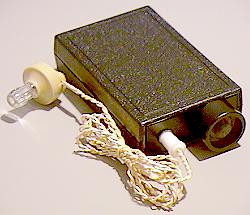 so loud, that some of them have special ear flaps
that close when they generate an ultrasound pulse so they won't
make themselves deaf. I thought something this loud should be
easy to detect !
so loud, that some of them have special ear flaps
that close when they generate an ultrasound pulse so they won't
make themselves deaf. I thought something this loud should be
easy to detect !
On retirement, I decided to undertake the development of field
instruments for bat research. One of the first devices I designed
used a simple and inexpensive circuit to make an ultra-portable,
personal bat detector. A picture of my original prototype unit is
shown at the left. It is small in size, lightweight, easy to
build, and can cost as little as $25 in parts. It turned out to
be an amazingly effective circuit so I dubbed it the Simple
Bat Detector.
I originally published the circuit for the Simple Bat
Detector in 1997. Since then, I've received emails from all
over the world, corresponding with many who have built the
detector from the information published on this page.
In 1998, I designed a circuit board for an enhanced version of
the detector, and started making kits
and assembled detectors available
for those who had trouble finding parts, or were unable to
assemble electronics. I've been thrilled by the many comments of
folks who have used the Simple Bat Detector to hear a bats
echo call for the very first time.... and have come to admire and
respect the bat as I do.
So far, the Simple Bat Detector has found its way to: Australia, Belgium, Canada, the Canary
Islands, the Cayman Islands, Costa Rica, England, Finland,
France, Germany, Ireland, Italy, Japan, Poland, Mexico, the
Netherlands, New Zealand, Scotland, Singapore, South Africa,
Spain, Sweden, Switzerland, and all over the United States.
How the SIMPLE BAT
DETECTOR works...
The Simple Bat Detector is a frequency division
type device. Frequency division type detectors allow you to hear
ultrasonic sound by digitally scaling the frequency down into the
human hearing range. For instance, a western pipistrelle bat
emits ultrasonic sound in the range 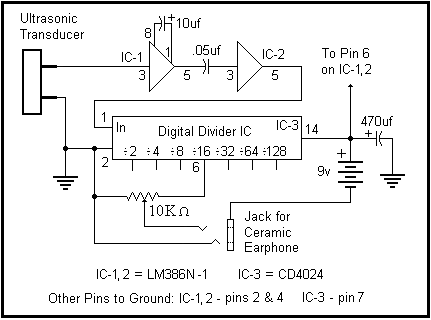 of
53 to 91 kHz. If you divide that frequency by 16, the new
frequency range is 3.3 to 5.7 kHz, easily within our hearing
range. Because the division is done digitally, all amplitude
information is lost. Ultrasonic sources processed by the detector
convert to sounds like geiger-counter clicks and chirps.
of
53 to 91 kHz. If you divide that frequency by 16, the new
frequency range is 3.3 to 5.7 kHz, easily within our hearing
range. Because the division is done digitally, all amplitude
information is lost. Ultrasonic sources processed by the detector
convert to sounds like geiger-counter clicks and chirps.
The basic circuit of the Simple Bat Detector is shown in
the schematic diagram to the right. It is essentially composed of
3 integrated circuits, or ICs. The signal from an ultrasonic
transducer is fed to IC-1, an LM386 audio amplifier, which is
configured to provide a signal gain of 200. The signal is coupled
to IC-2, a second LM386, by a .05 uf capacitor. IC-2 is
configured to provide an additional gain of 20, for a total
system gain of 4,000. The output of IC-2 is direct coupled to the
input of IC-3, a 7 stage CMOS digital divider circuit. The input
stage of the divider acts as a zero crossing detector, triggering
on the negative transition of the signal from IC-2. The divide by
16 output is connected to a potentiometer, which serves as an
audio level control. A high impedance ceramic earphone is
connected to the output of the level control. The 10K level
control is a small printed circuit pot that is set and forgotten.
The detector circuit is powered by a nine volt battery. ( The
numbers next to the IC nodes refer to the pin numbers of the IC's.
Note the additional pins listed at the bottom of the schematic
that need to be tied to ground. )
A major advantage of a frequency division detector is that
it is a wide band device ... that means it will let you hear all
detectable bat sounds without the need to tune the
detector to any particular frequency. Heterodyne detectors,
which process ultrasonic sound in the analog domain, only
convert a small range of frequencies at any given time - you must
select which frequencies to listen to. If you tune up around 60
kHz to listen for a pipistrelle, you may not hear the big brown
bats flying nearby. The frequency division detector works
in the digital domain, converting the full spectrum of
sound that the transducer is able to detect. So you get to listen
to all of the ultrasonic sounds around you, without missing
anything due to unfortunate tuning choices. I feel this no-knobs-needed
characteristic of the frequency division detector makes it
a great choice for the casual bat observer, and student.
Building a SIMPLE BAT
DETECTOR...
Although I have designed a circuit board
for an enhanced version of the Simple
Bat Detector, it is important to note that the basic circuit
shown above is very effective - and parts are available world-wide.
Many have built the detector in the same manner as I did with my
original prototype - on perf board - as shown to the left. If you
don't 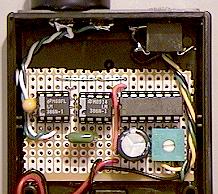
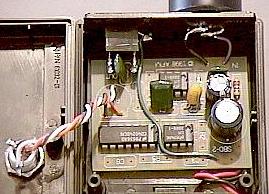 want to use the perf-board
technique, the circuit can always be assembled on the enhanced
PCB - as shown to the right. The circuit assembly is then mounted
inside the case with hot-melt glue.
want to use the perf-board
technique, the circuit can always be assembled on the enhanced
PCB - as shown to the right. The circuit assembly is then mounted
inside the case with hot-melt glue.
The ultrasonic transducer is simply mounted to the front panel by
drilling 2 small holes for the transducer pins, and bending the
pins over after inserting them through the panel.
Keep all wire lengths short, as very high gains are being
generated in IC-1 and IC-2. The picture on the right also shows a
method for installing an external volume control, if you feel one
is needed. The wiring of the earphone
jack is also a little tricky, as it is doubling as the power
switch ... so pay careful attention to the schematic above.
In order to accomodate various transducers, you can easily
tailor the gain of the two LM386 IC's. An additional resistor can
be added in series with the 10uf tantalum capacitor to reduce the
gain of IC-1. A resistor / capacitor combination can also be
added between pins 1 and 8 of IC-2 to increase it's gain. In this
way the total system gain can vary anywhere from 400 to 40,000.
Be sure to keep the positive side of the capacitor towards pin #1
on the LM386.
If you have experience in electronics repair or
assembly, you can usually build a Simple Bat Detector in a
single evening. I will always try to have a supply of circuit boards and components kits on hand for the Simple
Bat Detector, so if you have trouble finding parts - email me. Also, if you
don't solder, don't despair, completely assembled
detectors are also available!
As far as bat detector cases go, you can use the enclosure on the
parts list, or go creative
... This is an area where you can cut cost with a little
imaginative engineering. Here are a couple of prime examples...
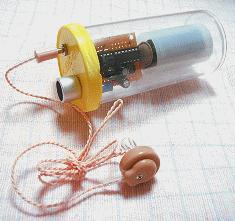
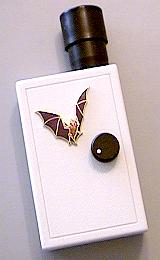
To the left is a picture of a Simple Bat Detector that was
cleverly designed by Hisafumi Tateno, in Japan, using a plastic
jar as the case. A film container was employed as a battery
holder. This design has the added benefit of letting you see
what's inside, as well as listening to bats !
The picture to the right is a detector I built for Jackie, my
spouse. Being married to a batty person like me, she deserved
something special. I used an off-white enclosure, and
added a cloisonné bat pin that I had found in a gift shop.
I would be interested to get other pictures from Simple Bat
Detector builders who have dared to be different. I could
always set up a gallery of the most interesting designs!
The instructions on this site have been made as complete as
possible to allow anyone to build the detector, with whatever
local resources that can be found. A resource list has been compiled
with part numbers, component sources, and email contacts in
several countries. The list is always changing based on
information I get from Simple Bat Detector builders via
email. If you construct a Simple Bat Detector, be sure to
send me an email and let
me know how it worked out for you.
Updates on the Simple
Bat Detector ...
 How does the Simple Bat Detector do in the
field ? Here are the Field Reports.
How does the Simple Bat Detector do in the
field ? Here are the Field Reports.

 Here's
a bat call recorded with a Simple Bat Detector ... BatCall1.wav (64KB).
Here's
a bat call recorded with a Simple Bat Detector ... BatCall1.wav (64KB). 
Where to find more
information about Bats:
Other Websites on
Building Bat Detectors:
- Bertrik
Sikken has lots of technical information on various
bat detector circuit designs - recommended reading !
Tony Messina - Las Vegas, Nevada - email: T-Rex@ix.netcom.com
First published September, 1997 - Last update:
May 17th, 2001
 so loud, that some of them have special ear flaps
that close when they generate an ultrasound pulse so they won't
make themselves deaf. I thought something this loud should be
easy to detect !
so loud, that some of them have special ear flaps
that close when they generate an ultrasound pulse so they won't
make themselves deaf. I thought something this loud should be
easy to detect !  of
53 to 91 kHz. If you divide that frequency by 16, the new
frequency range is 3.3 to 5.7 kHz, easily within our hearing
range. Because the division is done digitally, all amplitude
information is lost. Ultrasonic sources processed by the detector
convert to sounds like geiger-counter clicks and chirps.
of
53 to 91 kHz. If you divide that frequency by 16, the new
frequency range is 3.3 to 5.7 kHz, easily within our hearing
range. Because the division is done digitally, all amplitude
information is lost. Ultrasonic sources processed by the detector
convert to sounds like geiger-counter clicks and chirps. 
 want to use the perf-board
technique, the circuit can always be assembled on the enhanced
PCB - as shown to the right. The circuit assembly is then mounted
inside the case with hot-melt glue.
want to use the perf-board
technique, the circuit can always be assembled on the enhanced
PCB - as shown to the right. The circuit assembly is then mounted
inside the case with hot-melt glue. 
